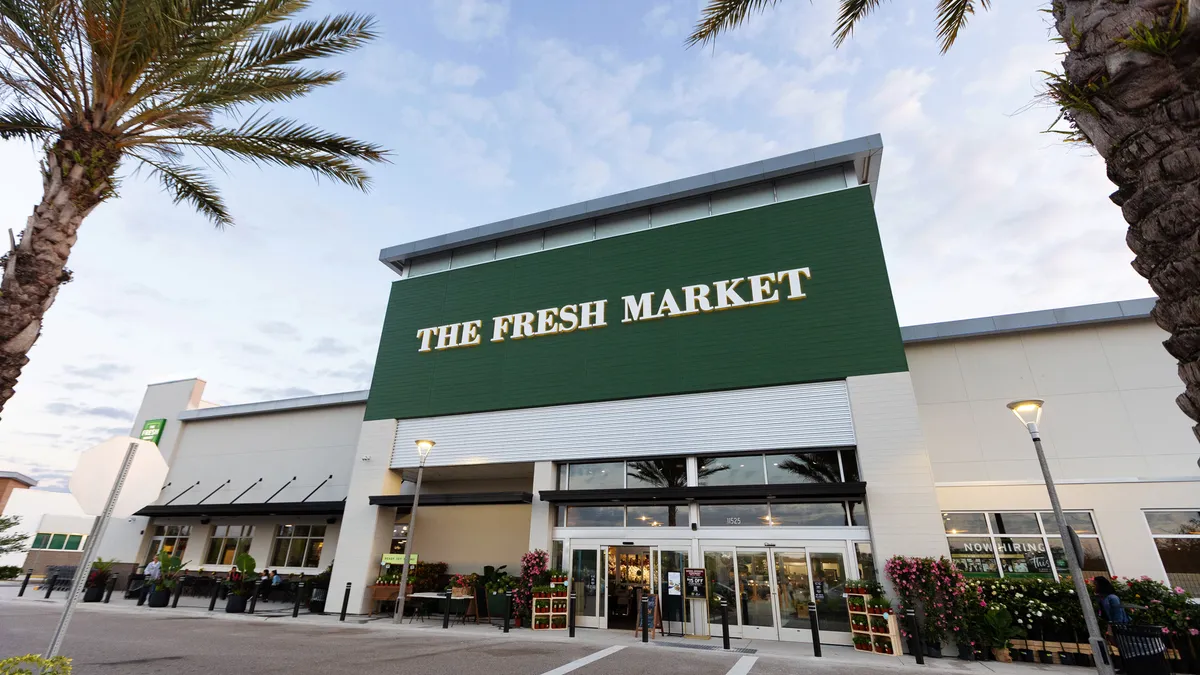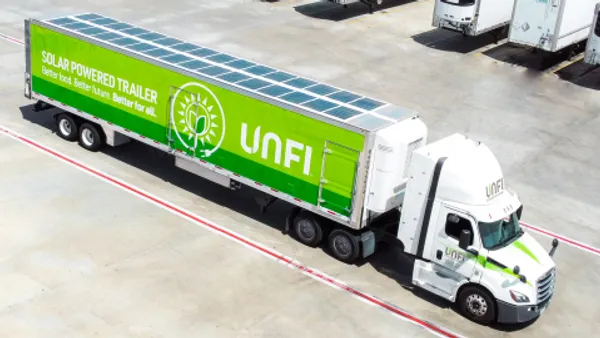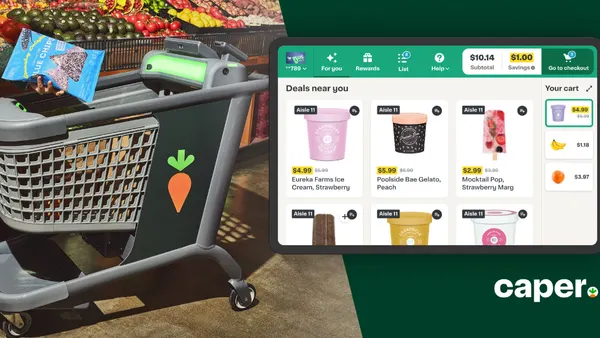Editor’s note: This story is the second installment in a monthly series looking at some of the biggest investments grocers and food companies are making. Previous articles sponsored by BMO Harris Bank can be found here.
At 9 a.m. sharp, Marty sets out for another 12-hour shift at the Giant Food store on Spring Garden Street in Carlisle, Pennsylvania. Polite, unassuming and the quintessential team player, the 6-foot-4 Marty is a model employee, always showing up for work on time and willing to tackle the same repetitive job every day without complaining.
As he traverses the perimeter of the 70,000-square foot store one Friday morning looking for spills and other safety hazards, employees stocking sausage, pasta, crab dip and bananas on shelves ahead of the weekend rush strike up a brief one-sided conversation with him. Some customers, especially young children, joyfully say "hi" to him or snap a selfie as they load their carts, while other shoppers appear unsure how to respond when they see Marty, or get agitated if he gets in their way.
Marty is not a human employee, of course — he's a robot, and one with high hopes riding on his slender, slow-moving frame. Ahold Delhaize, which oversees the Giant retail brand, aims to have an estimated 500 robots deployed across its Giant/Martin’s and Stop & Shop banners before the summer, part of an effort to not only reduce costs and improve store-level execution, but to communicate to consumers that the company is at the cutting edge of technology.
"We don’t want to put it in place just because it’s a robot. It has to provide benefit. As customers change, like millennials and Generation Z, they want to see more technology, more kiosks, more tablets, more self checkout, that kind of thing, so if we don’t leverage the technology that is out there now we’ll become irrelevant."

Tim Brady
Manager of deployment and strategic initiatives, Giant Food Stores
Other grocers have incorporated robots into their operations during the last year, too, including the 119-store Schnucks, retail giant Walmart and other banners that have purposely kept a more subdued profile. Despite their growing use, robots in U.S. supermarkets face a decidedly uncertain future as retailers differ on how best to deploy them and analysts question whether cash-strapped grocers would be better suited investing in other forms of technology that generate more immediate returns.
“We don’t want to put it in place just because it’s a robot. It has to provide benefit," Tim Brady, manager of deployment and strategic initiatives at Giant Food Stores who has overseen the deployment of Marty during the last year, told Grocery Dive. "As customers change, like millennials and Generation Z, they want to see more technology, more kiosks, more tablets, more self checkout, that kind of thing, so if we don’t leverage the technology that is out there now we’ll become irrelevant.”
The robot rollout for Ahold Delhaize has been gradual in order to give the grocer time to determine how best to use Marty, and to make some modifications while letting employees and shoppers get used to sharing space with a googly-eyed robot. For now, Marty, who moves at a glacial pace of one-and-a-half miles an hour, is only being used to monitor for safety hazards. Company officials will evaluate whether to incorporate other uses that improve customer service and boost efficiencies, like scanning shelves for out-of-stock products or checking price accuracy, as the technology evolves.
Marty, who has 10 embedded cameras that help him navigate the store and keep from running into distracted customers, has already paid dividends. Before the robot arrived, workers in Carlisle would amble through the store every hour checking for potential hazards, often finding little to justify their effort. Today, Marty has freed up workers to spend more time bagging groceries, stocking shelves, collecting shopping carts, picking up trash or cleaning bathrooms, according to store and company employees.
"For a store of this size, that's time consuming. There's definitely a benefit to it," said Billy Robinson, the store's assistant manager. "He really gives us the ability to take our focus off the smaller things and put them into service."
Still, Marty is not without challenges. On a snowy morning in early February, water that had collected on the floors repeatedly caused Marty to pause, requiring the attention of an employee each time to check for any hazards and reset the robot. "You're getting on my nerves this morning, Marty," one of the employees frequently tasked with resetting the robot playfully said.
Marty also struggled to navigate around new floor displays, including one containing yogurt, sour cream and cream cheese. Most consumers seemed oblivious to Marty, but a few appeared uncertain how to respond and would wait for it to pass or go around to avoid him. Other shoppers would bolt out from an aisle with their cart, oblivious of the oncoming robot, forcing Marty to come to an immediate halt to avoid a collision. It's not uncommon for someone in a hurry to get annoyed with Marty for getting in their way or feel they are being followed, Robinson said.
"It's still taking a little bit of time to get used to it because every time I see him it's still a little weird that he's in here," said Andrew Finton, who got startled coming around the corner after seeing Marty. "Sometimes I just think he’s a little creepy ... because he’s just a tall looking, skinny robot with googly eyes.”
'This isn’t about a PR stunt'
It's easy to see why more grocers are mixing robots in with their customers and employees. IHL Group estimated grocers and other retailers lose up to 4% in annual revenue, or roughly $448 billion a year, when a product is not in stock or the item has been misplaced. For grocery and drugs stores alone, 20% of shopping trips result in a customer experiencing an out of stock item, IHL noted.
Brad Bogolea, CEO of Simbe Robotics, the manufacturer of the Tally robot used by Schnucks and more than a dozen large retailers across the globe, said there is a vast, largely untapped market for robotics in stores. With retailers, brands and market insight companies spending billions annually for untimely or incomplete shelf data, Bogolea said, robots could play a major role in delivering more up-to-date and robust information that leads to higher sales. Simbe estimates real-time shelf information has the potential to be a $100 billion business.
Despite the financial benefit, Bogolea said retailers must take a measured approach in how they use robots and move cautiously. Some grocers, he said, are over-promising how robots will benefit their businesses before fully sussing out how they can tap into all the potential data points the machines generate — a misstep that could ultimately stunt the long-term growth of robotics in the field.
“You end up with these types of scenarios where people start to bring this type of technology into question or sort of the value of the technology into question," Bogolea said. "It’s important for the industry to take a highly calculated or measured approach for that reason. This isn’t about a PR stunt. It’s about transforming retail for a better customer experience.”
Among the U.S. grocers experimenting with robots, there has been a reluctance to implement the technology company-wide. Even Walmart, the world's largest retailer, has an autonomous, floor-scrubbing robot in 360 stores, a fraction of the 4,755 U.S. locations it operates. And retailers are taking a remarkably different approach in how they use robots in the store, including Walmart to clean, Ahold Delhaize to look for spills and Schnucks to check for out of stock items and incorrect pricing.
"Retailers are not experimental platforms. They are businesses. They have to make money so they want to experiment with this so they don't get caught unaware, so they are competitive and are in a position to know whether to move forward with this or not."

David Marcotte
Senior vice president, Kantar Consulting
David Marcotte, a senior vice president at Kantar Consulting, told Grocery Dive that the slow pace of adoption comes as supermarket chains are still learning what robots can do and which ones work best for their specific needs. They also are struggling to come to grips with the massive upfront investment a large-scale rollout would entail, a pause that has faced the industry before with new technologies such as scanning at the checkout. Initially, retailers started experimenting with scanning but soon determined it would only work if it was in place across the whole chain.
The downside of using robots at a handful of stores rather than across an entire banner is that it's harder for grocers to gauge the full impact, he said, as well as the benefits they could extract from the technology and whether it makes economic sense.
"Retailers are not experimental platforms. They are businesses," Marcotte said. "They have to make money so they want to experiment with this so they don't get caught unaware, so they are competitive and are in a position to know whether to move forward with this or not."
As robots become more advanced, what supermarkets can do with the data they collect could grow exponentially, Marcotte said, helping to further justify the cost and giving the green light to a broader rollout. Grocers, for example, could eventually tap into robot-mined data to schedule more timely truck deliveries. And if robots can perform additional tasks like stocking shelves — a job that would undoubtedly draw the ire of labor unions — it would increase their usefulness.
“In the current direction [robots are] going it’s viable. But it’s relatively narrow space in terms of what" they are currently doing in the store, Marcotte said. "I do think it’s going to be a very significant part of the business in another five years, and I think it’s going to look like something different than what we’re talking about .... but I don't know what that is because there’s too many things going on."
All about the data
At Schnucks, executives first stumbled upon Tally after a chance meeting with Bogolea, Simbe's CEO, during a conference in 2016. Even though the company wasn't actively looking for a robot at the time, it didn't take long for the executives to be tantalized by the potential data they could glean. A year later, the first Tally rolled through a store 15 miles from company headquarters.
Schnucks later tried out the robot, which scoots around on a Roomba-like base, at three of its busiest stores in the summer of 2017 in an effort to gauge its ability to gather data. Pleased with the results, Schnucks expanded the program last fall to at least 15 stores, providing the grocer with more accurate, frequent and comprehensive information.
Each scan conducts product and price tag audits (if a price doesn't match what is being advertised, for example), searches for out-of-stock items and recommends optimized locations for goods in the stores — resulting in real-time store information to improve operations and keep up with inventory. The information collected also is shared with interested brands and delivery partners to help them make sure they have the top-performing brands on shelves organized in the most impactful way possible.
“We’re more interested in the big data portion of this and understanding what we can do with that data once we get it back," Dave Steck, vice president of IT and infrastructure with Schnucks, told Grocery Dive. "Now that we’re getting it, we’re able to slice and dice it different ways. We’re getting a different perspective on the shelf than we’ve ever had before.”
The early results in the stores with Tally were immediate, a phenomenon Schnucks executives dubbed "The Tally Effect." Steck said shelf conditions quickly improved, with products more likely to be brought to the front of the shelf and properly placed, with workers in some cases looking to get ahead of the robot. Shelves also were better stocked, too, with Tally flagging products that were missing.
At locations without the robots, a Schnucks worker typically does one full inventory check of all 35,000 products each day — a process that can take up to four hours depending on the size of the store. Tally can make its rounds in a few hours and do the checks more often, up to three times a day.
“If the customer comes into the store and the item is on the shelf and they are able to buy it then they are likely to come back again, they’re going to be satisfied," Steck said. "That generally is going to translate to sales.”
Like other retailers using robots, the supermarket chain has drawn fire from consumers who claim it is replacing human workers with robots. Schnucks worked to get ahead of the issue by inviting media into its stores to discuss Tally and its role. The backlash quickly subsided, Steck said.
"The equation for me has never been, what's the [return on investment] based off of displacing people?" Steck told Grocery Dive last fall in announcing the expanded use of in-store robots. "We have enough labor shortages in the stores that I can't possibly hire enough people that I would displace anybody with a robot."
A healthy dose of skepticism
Neil Saunders, managing director of GlobalData Retail, expressed skepticism that robots are a worthwhile use of capital for the low-margin grocery space, where retailers are already spending hundreds of millions of dollars annually to remodel stores, grow their e-commerce footprint and implement other technological initiatives. Moreover, he said when a robot finds a spill or an out of stock item, it only does half the job before a human has to take over.
“There needs to be much more thought put into this ... I think some retailers are just jumping on the bandwagon," Saunders told Grocery Dive. "It’s like 'Oh, here’s a shiny new thing, let’s jump on board.' But actually, just because technology exists it doesn't mean you have to implement it.”
Saunders pointed to web giant Amazon, which has focused its technological prowess not on in-store robots but instead on enterprises such as Amazon Go where consumers can take products off the shelf and skip the inefficient checkout process. Brick-and-mortar stores, he said, would be better off helping the customer — and reducing their own costs — by investing in technology like scan-and-pay by phone. Eventually, Saunders said retailers will find that robots are not the best solution to cure woes in the front of the store.
"A googly-eyed robot traveling around the aisle of a quite dilapidated store that looks like it’s come out of the 1980's isn’t going to cut the mustard with customers. It really isn’t," he said. "What a lot of grocery retailers need to do is get a very firm grip on the basics of their operation.”
Steck, meanwhile, said he could see a time when Tally or another robot lives in all of its stores. But at the same time, everything the robot does for Schnucks, the company makes sure it can do the same jobs without Tally — even if it means doing them less frequently or more slowly. He even acknowledged assessing whether other robots could help the retailer.
"If you ask me [are robots] giving us a competitive advantage today, I would say probably not. But based off of the data that we’re getting it’s building us to be in a more competitive position in the future,” Steck said. “We’re building for the future and not just for today.”
This series is brought to you by BMO Harris Bank, a leader in commercial banking. To learn more about their Food & Beverage expertise, visit their website here. BMO Harris Bank has no influence over Grocery Dive's coverage.













